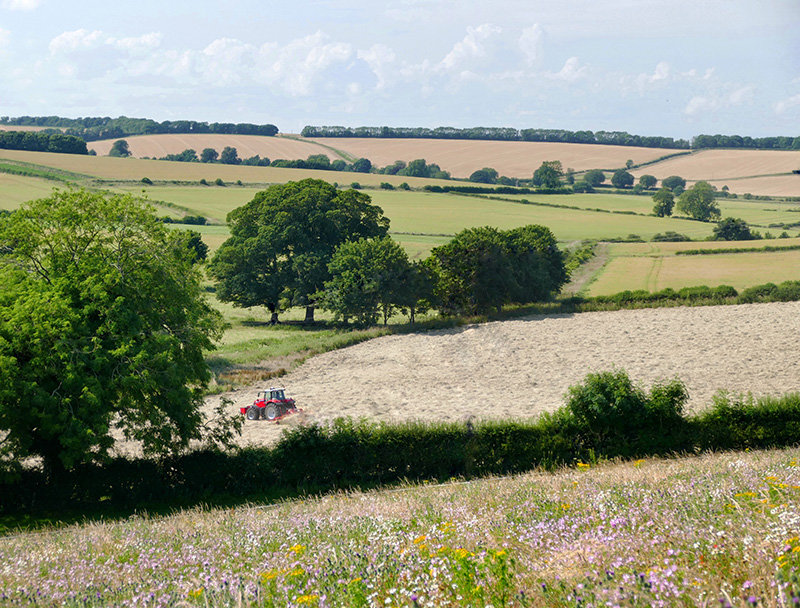United Kingdom
May 2, 2024

There’s no reason why you can’t be a conventional farmer who thinks like an organic farmer
Are weed control and nutrient management really the topics that keep organic dairy farmers awake at night?
“I don’t think they are,” says Janet Montgomery, Barenbrug UK’s Agricultural Product Manager. “They’re important topics, needing due consideration, just as they are for conventional farmers.
“But obviously organic grass farmers have fewer options available to them, so they use different tactics to achieve the same results.”
With grass the most vital input in any dairying system, the strict regulations concerning organic production serve only to highlight the importance of home-grown feeds. That same sentiment is increasingly sharpening the minds of conventional farmers, too.
“Many farmers recognise that they have choices to make when it comes to how they farm,” Janet points out. “Some would go so far as to say it’s their responsibility to farm more effectively, more sustainably. And the way they’re doing that is to look at where their farm inputs originate – soybean meal, for example – and the potential impact they can have if they exercise a different choice or follow a different route.
“That doesn’t necessarily mean they’re thinking about going organic, but they might look to reduce their reliance on bought-in feed. There’s a rising movement in conventional agriculture that some of the practices observed over many years by organic farmers are applicable in non-organic situations too.”
Janet also points to the mushrooming interest in regenerative agricultural practices. “Regenerative agriculture can be a little amorphous in terms of what it actually means to practise it,” she acknowledges, “but the central themes of soil health, carbon sequestration and biodiversity are now widely accepted.”
So, can the ‘regen-curious’ cohort benefit from techniques practised by their organic counterparts?
“Absolutely,” says Janet, “and one of the first steps is to reframe the talk around what varieties go into the sward.
“We’ve come a long way in a relatively short time, with additions to the classic ryegrass-based systems. Mixtures intended for use in organic systems have always looked different from our more conventional mixtures, because we’ve different objectives.
“But those lines of distinction have blurred, as first herbal leys and then SFI mixtures, or swards for biodiversity, became more common,” she explains.
Janet, who’s responsible for developing the many different mixtures offered by Barenbrug in the UK, says each grass mixture demands a lot of work. “I’m thinking how species and varieties – particularly new ones – will perform in the circumstances. I ask myself, ‘What farming challenge am I trying to provide a solution for?’
“It’s driven by agronomy. For example, am I looking for something that offers farmers a quick spring growth? Are we meant to be delivering winter tolerance? Is this mixture suitable for the summer dry?”
Unsurprisingly, the primary questions for organic mixtures involve weed suppression and nutrient management. “Organic farmers can’t use herbicides and they can’t use artificial fertilisers, so we create mixtures that can thrive without those inputs.
“But this is where we’ve started to see real interest from conventional farmers who want to avoid the expense and hassle of spraying for weeds, and who want to manage without chemical fertilisers.”
Swards ‘designed for organic’ typically sport a high tiller density, explains Janet, creating a pasture that’s always ‘on the offensive’. Dense and healthy, weed seedlings can’t compete against grass, or grass-clover stands.
“White clover can reasonably provide up to around 150kg/ha of nitrogen,” she points out, “while red clover – an accessible boost for silage quality – can reach as much as 250kg/ha.”
Another benefit that clover, other legumes and herbs bring to a sward is the variation in rooting characteristics, which in turn is a major driver of good soil health. “A diversity in root depth and structure is very effective in improving nutrient cycling,” Janet stresses.
“Different plants are active in different zones, at different times through the year,” she continues. “That has a tremendously beneficial effect on soil health and fertility, keeping nutrients moving through the profile throughout the year.
“That’s great for the health of the sward but also for the health of your animals: research shows that these diverse swards offer grazing animals a more balanced – in terms of minerals and vitamins – intake, plus the different proteins available when grazing involves more than grass alone.”
Illustrating the point, Janet says that while ryegrass roots grow to a depth of around 15cm, a suitably biodiverse mixture would root ten times deeper.
“Not just the herbs and legumes, either,” she adds. “Tall fescue’s roots grow as deep as 1.5m, which explains why it remains so productive during dry periods.”
Janet says the organic movement’s early adoption of species like tall fescue is a good example of how organic farming has made the most of its own restrictions. “They’ve simply added more tools to the toolbox. Their solutions are like a patchwork quilt – lots of little solutions or adaptations, recognising that they don’t have the blanket options of ag chem and fertilisers.
“Instead, it’s physical, cultural, temporal control, and cumulatively, these allow for the variation in management approaches which together deliver the desired outcomes.
“The point is, there’s no reason why you can’t be a conventional farmer who thinks like an organic farmer.”